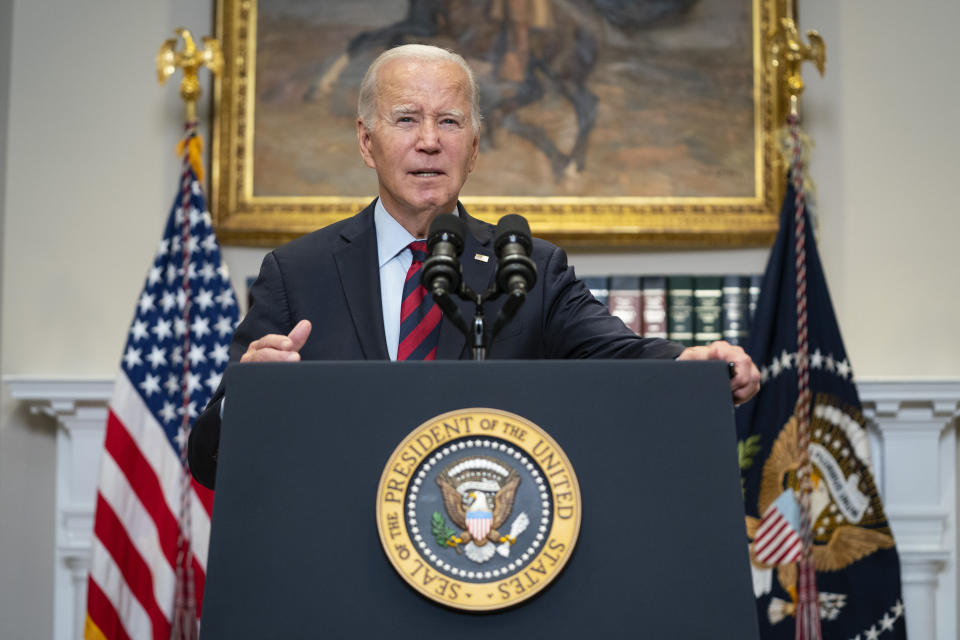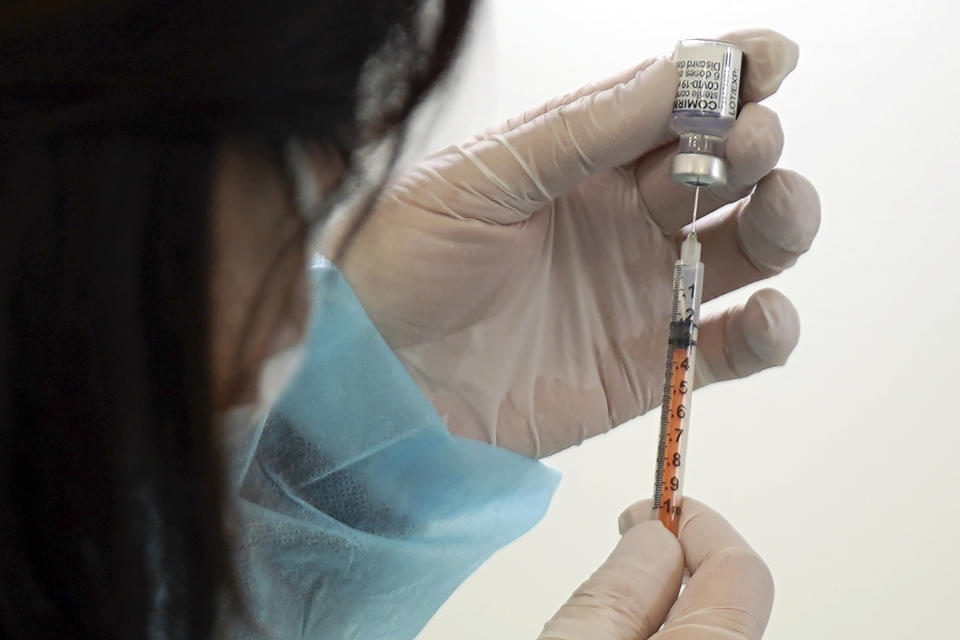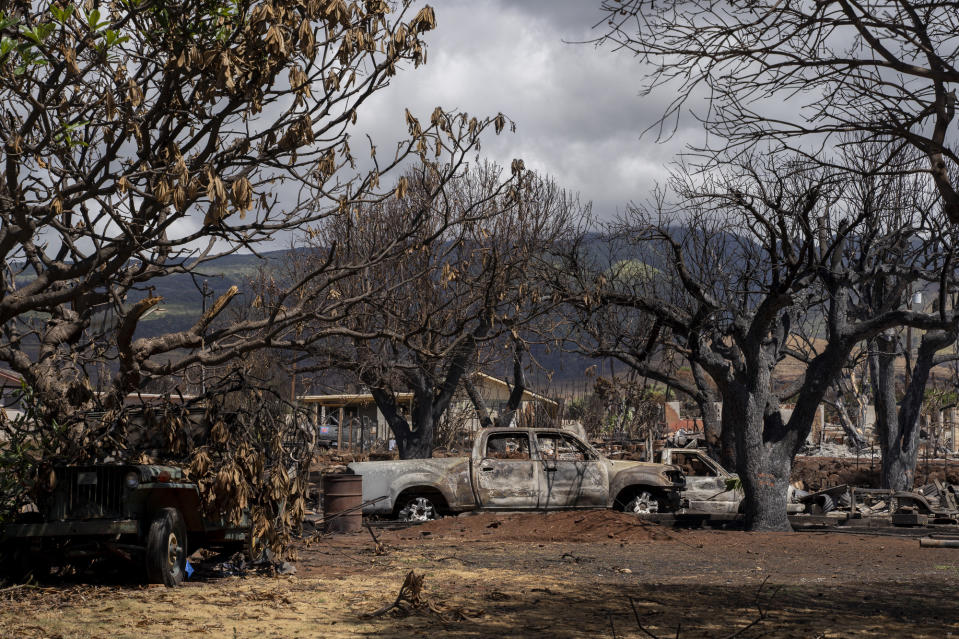NOT REAL NEWS: A look at what didn't happen this week
A roundup of some of the most popular but completely untrue stories and visuals of the week. None of these are legit, even though they were shared widely on social media. The Associated Press checked them out. Here are the facts:
___
No, migrants do not receive $2,200 each month from the federal government
CLAIM: The Biden administration is giving people who enter the U.S illegally payments of $2,200 per month.
THE FACTS: Those who are in the U.S. illegally are not eligible for any cash assistance, with rare exceptions, immigration experts told The Associated Press. Certain groups, such as refugees and people granted asylum, can receive financial benefits from the federal government, though not as high as $2,200 each month. The issue has been misrepresented before online, and reemerged this week. One tweet states: “According to a release by the legal immigration group ALIPAC, the Biden administration is giving some illegal aliens payments of $2,200 per month!” The Americans for Legal Immigration PAC did publish this claim, relying on an Aug. 21 Tucker Carlson interview with retired Army Col. Douglas Macgregor, who said that “every alleged asylum seeker, illegal migrant pouring in through the border in Texas or wherever else” is given a monthly payment of $2,200. But immigration experts say that's false. “Generally, unauthorized immigrants have very little access to federally-funded public benefits,” Julia Gelatt, associate director of the U.S. immigration policy program at the Migration Policy Institute, told the AP in an email. “They can mostly only access emergency, in-kind things like shelter and food during a hurricane or other emergency, or emergency healthcare.” Asked for further evidence of the group’s claim, ALIPAC President William Gheen acknowledged that “by law illegals are not supposed to receive payments from the federal government,” but claimed they are being “misclassified” as asylum seekers and refugees, and pointed to the MacGregor interview as the source of the $2,200 figure. Macgregor, however, cited an article published by a Houston radio station that quotes Gheen and the ALIPAC release, and was published a week after his interview with Carlson. Regardless, certain Cubans and Haitians are the only people who can receive federal cash assistance while in the U.S. illegally. Those who qualify include nationals of these countries whose cases for removal from the U.S. are still being decided or who have a pending application for asylum. They can apply for the same assistance available to refugees and people granted asylum — both groups that have legal status in the U.S. Those granted asylum include individuals who face persecution and applied for protection while already in the U.S. Stanford Prescott, a spokesperson for the International Rescue Committee, told the AP that “none of these programs provide a regular monthly payment of $2,200” and that they “typically have strict limitations on eligibility” and length. For example, the Refugee Cash Assistance program provides people who do not have minor children with financial help to meet basic needs such as food, shelter and transportation, for up to 12 months. The amounts vary by location, but according to Gelatt, “seem to be under $1,000 for a couple, less for a single person.” Similarly, the Temporary Assistance for Needy Families program provides financial support to families with minor children. These benefits also vary by state and family size, but Gelatt said they are still less than $2,000 a month," even for a very large family in a more-generous state.” For instance, a household with three children in New York could receive $698 per month for up to 60 months. The U.S. Department of State also provides local resettlement agencies with a one-time payment of $2,375 per refugee — $1,275 of that amount can be used for critical needs such as rent, food and clothing, while the rest is earmarked to fund access to services such as cultural orientation, locating housing and legal help. Mark Miller, a State Department spokesperson, said the agency “does not provide payments or assistance to undocumented immigrants in the United States.” Refugees, people granted asylum and certain other groups may also be eligible for supplemental security income if, for example, they are aged 65 or older, blind or disabled. The maximum monthly SSI payment is $914 for an individual and $1,371 for a couple.
— Associated Press writer Melissa Goldin in New York contributed this report.
___
Differing infant mortality rates in Japan and the US are not connected to vaccine policies
CLAIM: Japan stopped mandatory childhood vaccinations in 1994, vastly improving the country’s infant mortality rate. By contrast, the U.S. has the highest childhood vaccination rate and has “the worst infant mortality rate of the western nations.”
THE FACTS: Both countries have similar and very high childhood vaccination rates, despite their differing policies. And while it’s true that Japan has a lower infant mortality rate than the U.S., public health experts say it is not because of vaccines, which actually reduce death in vaccine-preventable diseases. Nevertheless, social media users are sharing an Instagram post claiming that after Japan banned the MMR — or measles, mumps and rubella — vaccine and eliminated mandatory vaccines, the infant mortality rate decreased “as a result.” “The United States has the worst infant mortality rate of the western nations and we v@ccinate the most,” it concludes. While it’s true that Japan’s infant mortality rate is far lower than the United States’, and that childhood vaccines aren’t required in the Asian nation, there is no connection between the two, experts say. “To point to vaccinations as the cause, one would need a randomized clinical trial showing that infant vaccines have increased infant deaths,” said Alice Chen, vice dean for research at the University of Southern California’s Sol Price School of Public Policy. “No such data that I am aware of does that.” In 1989, cases of aseptic meningitis in children who received a combined vaccination for measles, mumps and rubella, or MMR, prompted lawsuits against the government, forcing it to scrap the mix four years later. However, kids can still be inoculated against the three diseases, just with separate injections. Japan revised its vaccination law in 1994 to scrap mandatory inoculation, but the country still recommends people get vaccinated and childhood vaccination rates are very high. For example, in 2022, 99% of Japanese kids had at least one dose of the diphtheria, tetanus and pertussis — or DTaP — vaccine, according to data from the World Health Organization and UNICEF. The rate in the U.S. was 98%. And in 2021, the vaccination rates for both rubella and the first dose of the measles shot were around 95% in Japan and 92% in the U.S., according to data from WHO and UNICEF. Data for mumps vaccination was not readily available, but it reportedly remains lower in Japan, where it is not classified as a routine inoculation. Additionally, Japan’s infant mortality rate gradually decreased over time, not dramatically after 1994, according to the infant mortality rate total estimates from the United Nations Inter-agency group for Child Mortality estimation, a group led by UNICEF. U.N. data shows Japan’s infant mortality rate was around 1.7 deaths per 1,000 live births in 2021, versus approximately 5.4 deaths per 1,000 live births in the U.S, which is indeed higher than most other Organization for Economic Cooperation and Development, or OECD, nations. The Centers for Disease Control and Prevention reported in 2021 that the leading causes of infant death in the U.S. were birth defects, preterm birth and low birth weight, maternal pregnancy complication, sudden infant death syndrome — or SIDS — and injuries such as suffocation. Emily Oster, a professor in economics at Brown University who researches infant mortality, noted there has been a large decline of infant deaths due to SIDS due to preventative steps parents have taken, such as having infants sleep on their back. The reasons for these poor outcomes are unclear, though Oster and Chen conducted a study that found higher infant mortality rates in the U.S. versus Europe were driven by those with a lower socioeconomic status.
— Associated Press writer Karena Phan in Los Angeles contributed this report.
___
Thousands of children are not missing on Maui
CLAIM: Thousands of children are missing following the deadly wildfires on Maui.
THE FACTS: Lists compiled by the Maui Police Department and the FBI contained only one minor who was unaccounted for following the August fires, and the child was later identified as a victim of the blaze. Despite this, false claims that thousands of children remain missing are spreading on social media. “What happened to the missing children of Maui?” asks one Instagram post which includes footage from the wildfires and their aftermath. “According to some adamant news sources, only 122 names remain ‘unaccounted’ for.” A tweet similarly states: “Not forgetting the 2000 missing children from Maui.” But just one child was ever officially reported as missing when official lists were released. A list of people unaccounted for after the wildfires released by the Maui Police Department and the FBI on Sept. 1 named 385 people, only one of whom was a minor. It has since been confirmed that he died in the wildfires, according to local newsreports. No other minors were included on foursubsequentlists, including the most recent, which was released on Sept. 29 and names only 12 people. More than 3,200 people were initially reported missing, according to a County of Maui press release. The Maui Police Department and the FBI first released a list of 388 validated missing individuals on Aug. 24, though this list did not denote whether individuals were minors. “Unfortunately, not all information is accurate or unbiased, and it is not uncommon for those who wish to cause panic to sensationalize events or present partial information that may not accurately reflect the reality of a situation,” Alana Pico, a Maui Police Department spokesperson, wrote in an email to The Associated Press. The Hawaii Department of Education is tracking students whose schools have been affected by the wildfires as they choose alternate education options. It noted in an Aug. 24 report that out of 3,001 students who had pre-registered at Lahaina public schools prior to the wildfires, 2,025 had not re-enrolled at another public school or opted for distance learning as of Aug. 21. The most recent data states that as of Oct. 3, the Department of Education had not achieved some form of active contact with just 13 students. Officials previously said they believed at least 115 people had died in the Maui wildfires, but that number dropped to at least 97 after testing discovered multiple DNA samples from some of the victims.
— Melissa Goldin
___
Find AP Fact Checks here: https://apnews.com/APFactCheck
___
Follow @APFactCheck on Twitter: https://twitter.com/APFactCheck



